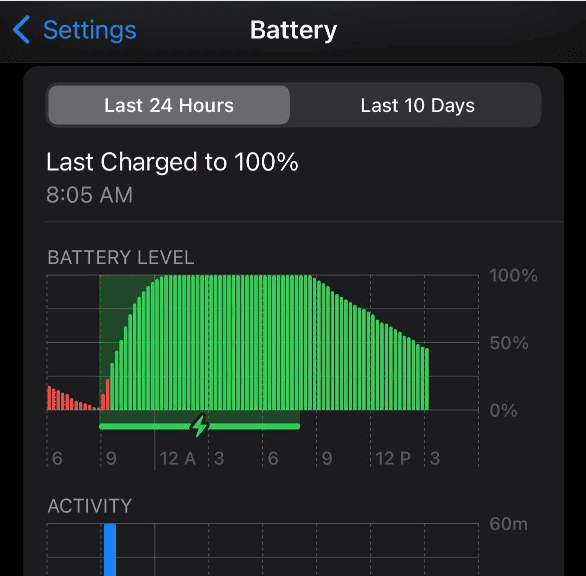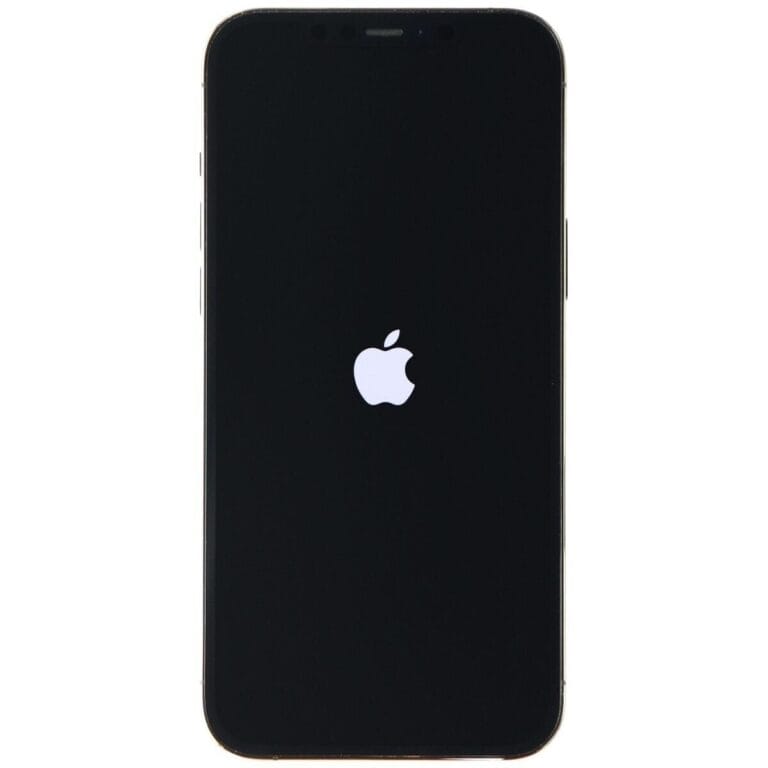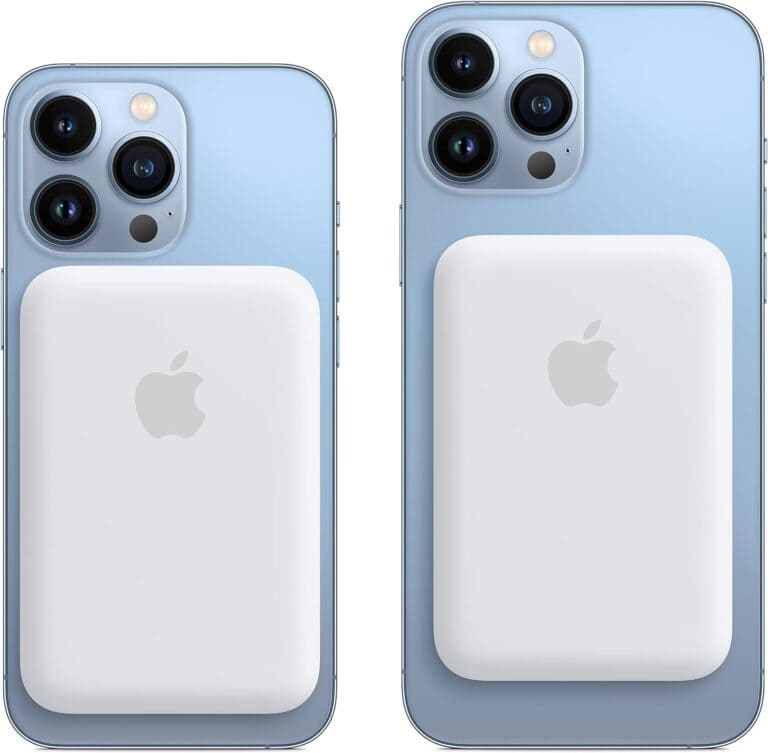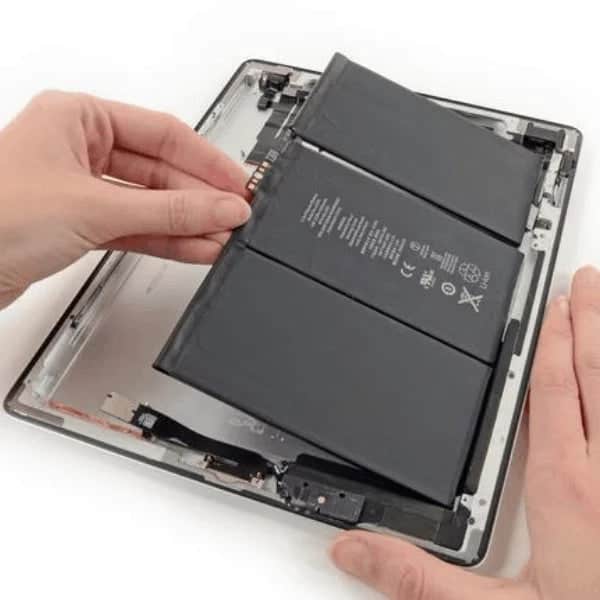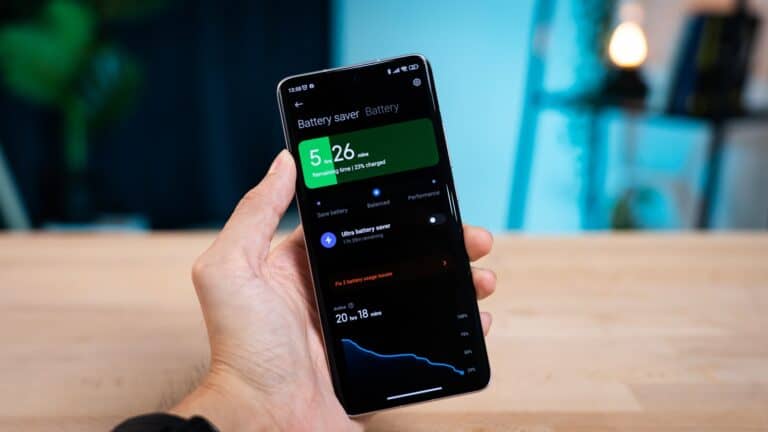Your iPhone’s battery is a lithium-ion battery, designed to last for a certain number of charge cycles. A charge cycle is when you use all of the battery’s power, but it doesn’t necessarily mean a single charge. For example, you could use 75% of your battery’s capacity one day, then recharge it fully. If you use 25% the next day, you’ve completed one charge cycle. Apple estimates iPhone batteries are designed to retain up to 80% of their original capacity at 500 complete charge cycles.
1. The Ideal Charge Range
- Keep your iPhone between 20% and 80% for daily use.
- Avoid letting it drop to 0% (deep discharge) or sit at 100% for long periods.
- Occasional full charges are fine, but not daily.
👉 Think of your battery like a muscle: keeping it in the middle range reduces stress.
2. When to Plug In
- At ~20–30%: This is a good time to recharge before your battery gets too low.
- Unplug at ~80–90%: This avoids the extra wear caused by holding a full charge.
- Overnight charging: Safe if you enable Optimized Battery Charging (see below).
3. Use Optimized Battery Charging
Apple includes a feature that learns your routine and delays charging past 80% until you need it.
- Go to Settings > Battery > Battery Health & Charging > Optimized Battery Charging → Turn it On.
- Example: If you charge overnight, your iPhone will pause at ~80% and finish charging right before you wake up.
4. Avoid Extreme Conditions
- Heat is the #1 battery killer. Don’t charge in direct sunlight, hot cars, or under heavy gaming while plugged in.
- Cold slows charging, but doesn’t cause permanent damage like heat does.
5. Fast Charging vs. Slow Charging
- iPhones support fast charging, but using a slower 5W or 10W charger can reduce heat and stress if you don’t need a quick top‑up.
- Wireless charging is fine but generates more heat—use occasionally rather than as your main method.
6. Long‑Term Storage Tips
If you won’t use your iPhone for weeks/months:
- Store it at around 50% charge.
- Keep it in a cool, dry environment.
7. Myths About Charging
❌ Myth: You must fully drain your battery before charging.
✅ Truth: Frequent small charges are better than full drain‑to‑100% cycles.
❌ Myth: Charging overnight ruins your battery.
✅ Truth: With Optimized Battery Charging, overnight charging is safe.
✅ Quick Charging Habits for Maximum Longevity
- Plug in around 20–30%
- Unplug around 80–90%
- Enable Optimized Battery Charging
- Avoid heat during charging
- Use slower charging when possible
Maximizing Your iPhone’s Battery Life
Aim for Partial Charges
Contrary to popular belief, it’s actually better for your battery to avoid charging it from 0% to 100%. Instead, try to keep your battery level between 20% and 80%. This can help prolong its lifespan.
Avoid Extreme Temperatures
Both heat and cold can negatively impact your iPhone’s battery. Avoid leaving your phone in direct sunlight or in a hot car. Similarly, try not to expose it to freezing temperatures for extended periods.
Overnight Charging
While it’s generally fine to charge your iPhone overnight, consider using Apple’s “Optimized Battery Charging” feature. This feature learns your daily charging routine and waits to finish charging past 80% until just before you usually unplug your phone. This can help reduce the time your battery spends fully charged, which can be beneficial in the long run.
Use a Quality Charger
Use a genuine Apple charger or a reputable third-party charger that’s MFi-certified (Made for iPhone). Cheap or counterfeit chargers may not regulate the voltage properly, which can damage your battery.
Check Battery Health
You can check your iPhone’s battery health in Settings > Battery > Battery Health. This will give you an idea of how much capacity your battery has left and whether it’s time to consider a replacement.
Table: Charging Recommendations for iPhone
| Scenario | Best Practice |
|---|---|
| Daily Use | Charge your phone whenever convenient, aiming to keep it between 20% and 80%. |
| Overnight Charging | Use Apple’s “Optimized Battery Charging” feature. |
| When Not in Use | Store your iPhone with a partial charge (around 50%). |
| When Traveling | Carry a portable charger for on-the-go charging. |
Remember, these are just guidelines. Your individual charging habits may vary depending on your usage patterns and needs. The most important thing is to be mindful of how you charge your iPhone and take steps to avoid unnecessary stress on the battery.
Understanding iPhone Battery Health
Getting the most out of an iPhone’s battery involves more than just plugging it in. It’s crucial to understand how the battery works, how various factors can affect its life, and how to keep track of its health through the built-in tools in iOS.
The Science of Lithium-Ion Batteries
Lithium-ion batteries power iPhones, providing reliable energy in a compact form. These batteries have a higher energy density which means they can hold more charge in a smaller space compared to older types of batteries. To keep them running optimally, it’s best not to expose them to extreme temperatures—Apple advises avoiding anything over 95° F (35° C) as it can shorten the battery’s lifespan.
Factors Affecting Battery Longevity
Several factors come into play when we talk about an iPhone battery’s longevity. Its chemical age, which is a mix of the battery’s actual age and its temperature history, influences how long it can effectively hold a charge. Functionality can be reduced in very cold conditions, turning temporary performance into a permanent state if the battery is repeatedly subjected to such environments.
Monitoring Battery Health with iOS
Apple includes a handy feature to keep tabs on battery health. Users can find this under Settings > Battery > Battery Health & Charging. This screen provides insight into the battery’s maximum capacity and whether it can still deliver peak performance. For users who want to minimize battery aging, the Optimized Battery Charging function adjusts the charge based on daily routines, attempting to reduce wear on the battery.
Charging Your iPhone Correctly
Ensuring your iPhone maintains its battery health requires understanding the best charging practices. With the right approach, you can extend your battery’s life and improve its overall performance.
When to Charge Your iPhone
The ideal time to start charging your iPhone is before its battery drops below 20%. Letting it fall to 0% can strain the battery and reduce its longevity. Optimized Battery Charging, a feature available on iPhones, adapts to your charging habits by pausing the charge at 80% and resuming later to complete the charge, thereby reducing battery aging.
Charging Practices to Avoid
Avoid charging your iPhone in extremes of temperature, especially heat, as it can cause overheating and damage the battery. Using a non-certified charger or using third-party wireless charging solutions that aren’t MagSafe-compatible may also risk damaging your iPhone. Also, avoid leaving your phone to charge overnight frequently, as keeping it at 100% for extended periods can wear out the battery faster.
Maximizing Battery Life and Performance
To get the most out of your iPhone’s battery:
- Use a certified charger, preferably with MagSafe or wireless charging designed for your model.
- Activate Low Power Mode when the battery is low to help extend its life.
- If your iPhone supports fast charging, use it sparingly to avoid potential long-term battery damage.
- Regularly check your iPhone’s Battery Health to see if the Optimized Battery Charging is active or if it needs to be turned on.
- Keep your iPhone’s software up to date to ensure you have the latest battery performance and charging optimizations.
Choosing the Right Accessories
When it comes to keeping your iPhone powered up, the right accessories can make all the difference. They ensure that your device charges effectively, stays protected, and maintains its battery health over time.
Selecting Chargers and Cables
Choosing the correct charger and cable for your iPhone isn’t just about convenience—it’s also about safety and efficiency. iPhones come with a USB-C to Lightning or a USB-C to USB-C cable, depending on the model. When picking a charger, consider opting for one that supports Apple’s MFi (Made for iPhone) certification, ensuring compatibility and safety. For fast charging, look for a minimum wattage of 18W. However, newer iPhone models can utilize higher wattages for quicker energy top-ups.
- Cable: Go for Apple-certified cables or those with positive reviews.
- Charger: A USB-C power adapter is recommended for fast charging.
Wireless Charging Considerations
Wireless charging is all about simplicity, but it still requires the right equipment. iPhones support Qi wireless charging, and Apple offers its own MagSafe chargers which magnetically attach to the back of the device. When using third-party wireless chargers, make sure they have a good reputation and offer adequate wattage for efficient charging.
- Wireless Charger: Ensure compatibility with Qi wireless charging.
- MagSafe: For newer iPhones, consider Apple’s own MagSafe chargers for a secure fit and efficient charging experience.
Protective Cases and Battery Impact
Using a protective case is crucial to safeguard your iPhone from accidental drops and wear. However, some cases might affect the charging speed, especially if they are too thick or not compatible with wireless charging. Always check if the case is MagSafe-compatible or supports wireless charging, if that’s a feature you regularly use. Additionally, cases certified as Made for iPhone are likely to provide the best fit and function without interfering with charging capabilities.
- Protective Case: Choose cases that are MagSafe-compatible or allow for efficient wireless charging.
- Battery Performance: Cases that support optimized charging can help maintain battery health by managing the charge level and preventing the battery from holding at the 80% limit for extended periods.
Frequently Asked Questions
This section covers some of the most common concerns about charging an iPhone and provides insights into ideal charging practices and battery maintenance.
How can I charge my iPhone correctly to maximize battery lifespan?
To maximize the lifespan of your iPhone battery, it’s best to charge it at regular intervals and avoid letting the battery completely drain. Charging when it’s convenient for you is generally fine, and you can remove the phone from the charger even if it hasn’t reached 100%.
Is it advisable to leave my iPhone charging overnight?
Modern iPhones are designed to manage battery health effectively, so leaving your iPhone charging overnight should not significantly impact the battery’s lifespan.
What is the ideal battery percentage to start charging my iPhone?
There’s no strict rule about the ideal battery percentage to start charging. However, it’s a good practice to charge your iPhone before it drops below 20% to avoid any unexpected shutdowns.
How do I maintain my iPhone battery health at its best?
Maintain your iPhone’s battery health by avoiding exposure to extreme temperatures and charging your device within ambient temperatures preferably under 95° F (35° C). Keep the battery life in mind when using power-intensive features or apps.
Should I aim to charge my iPhone up to 80% or 90% for optimal battery health?
Charging your iPhone up to 80% or 90% is generally sufficient for daily use and can be good for longevity. However, charging it to 100% is not harmful due to the built-in battery management system.
What practices should I follow to keep my iPhone battery health near 100%?
To keep your iPhone’s battery health in top condition, avoid complete discharge cycles, remove certain heavy-use cases during charging that may cause overheating, and follow recommended usage and charging practices as suggested by the manufacturer.

